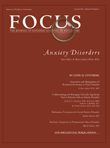From the Guest Editor
We all have challenging patients who present with clinically significant anxiety. Some do not respond to the initial treatment. Other patients may present with clinically important symptoms that coexist with anxiety disorders that complicate both assessment and treatment planning.
This issue of FOCUS includes three reviews that address some of these challenges. The first addresses inadequate response to treatment in patients with panic disorder. It includes suggestions for optimizing initial treatment and suggests a differential diagnostic process for identifying the reason(s) for inadequate treatment outcome. Suggestions for addressing identified causes for inadequate treatment outcome are provided. The second review by Dr. Gordon Asmundson and colleagues addresses the common overlap of anxiety disorders with chronic pain with emphasis on posttraumatic stress disorder (PTSD). They review evidence for this overlap and describe possible biopsychosocial models that may explain it. Strategies for assessment and treatment of this important subgroup of anxious patients are presented. The third review by Dr. Mark Hamner addresses the significant subgroup of individuals with PTSD who also have secondary psychotic symptoms (PTSD-SP). He provides a review of the relevant literature and summarizes the expert consensus on how these individuals fit into the current diagnostic system. Biological and psychosocial aspects of this potential subgroup are presented, as is a summary of what we know and what we need to know about treating this important subgroup of individuals with PTSD.



